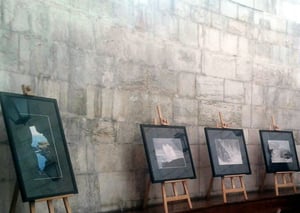The photography exhibition “The Power of the Sublime”, by Dina Salvador, opened at the high choir of the National Pantheon. «The power of Sublime», a set of photos with themes of sea, cliffs and waves, where nature has created wonderful shapes and colors. It is a sample of the work captured and produced by the artist born in Lagos. Dina Salvador has worked for several public and private entities and since 2004, she has been involved in a project to recover the Atlantic Forest, in the Recôncavo Baiano. For 15 years he has been sharing his life between Portugal and Brazil.
In the waters in love with the swirling sands, in the giant waves, sent by Hercules, in the sandstone cliffs, painted in ocher tones, in the mysterious algars, gnawed by the ancient waters, in the long dusk of fire, on the evening sea, the sublime is manifest and giant.
When the sea and the sky merge, in a mirrored horizon that merges with the clouds of the sky, in serene stillness, made of silence and magic, so eloquent and its splendor that it dispenses all words. Timeless moments, made of light and breathtaking beauty, with no wind or breeze whatsoever, like a miracle of the gods, made a gift to the senses, in a rare balance with the sublime, the eyes are diluted in the blue and the sweet air of eternity is breathed.
Science and art have always accompanied it. From an early age and as a hobby, he started in nature photography, traditional architecture, boats and fishing gear, among many other themes.
Dina Salvador – Photographer for more than 30 years, as a hobby, taking between 60 and 70 thousand photos on various topics. «The power of the Sublime» mostly from the southwest coast, it is an interface zone, where the land ends and the sea begins. Basically, it is the richest and most diverse area. The southwest coast have the sea, cliffs, flora, fauna. The combination of these elements, is spectacular. And everything changes. There, the artist is always see different things. There is fog, there is no fog, the light is different, depending on the time of day and the season. On the west coast, which, due to its more aggressive climate, provides material with better shapes and more irregularities. The work is already there. The artist is nature.
In short, biologist and the artist, on the contrary. It is a very harmonious symbiosis. The artist find things and got used to looking at nature with different eyes. Generally, the artist discover things more interesting because her biologist specific knowledge.
National Pantheon of Portugal
The National Pantheon honors some of the most important personalities of Portuguese history and culture of all times, Presidents Manuel de Arriaga, Teófilo Braga, Sidónio Pais and Óscar Carmona, writers Almeida Garrett, Aquilino Ribeiro, Guerra Junqueiro and João de Deus, the artist Amália Rodrigues and the Marshal Humberto Delgado.
The current building of the Church of Santa Engrácia substituted previous churches dedicated to a martyr of the city of Braga, Saint Engrácia. The first church dedicated to the Saint was sponsored by Infanta Maria of Portugal, Duchess of Viseu, daughter of King Manuel I, around 1568. In 1681, construction of the current church began after previous structures collapsed. The design was the work of João Antunes, royal architect and one of the most important baroque architects of Portugal.
Construction proceeded from 1682 through 1712, when the architect died. King John V lost interest in the project, concentrating his resources in the gigantic Convent of Mafra. The church was not completed until the 20th century, so that Obras de Santa Engrácia (literally Saint Engrácia’s works) has become a Portuguese synonym for an endless construction project. A dome was added, and the church was reinaugurated in 1966.
In 1916, during the First Portuguese Republic, the Church of Santa Engrácia was converted into a National Pantheon. It was completed only in 1966, during the government of the Dictator António de Oliveira Salazar. There was much speculation that it was completed for the eventual death of Salazar and other high ranking Estado Novo officials, but this was proven false when he died in 1970 and his wishes were revealed to be buried in his hometown of Vimieiro near Santa Comba Dão, which was carried out. Besides Oscar Carmona, no other Estado Novo officials were entombed there.



